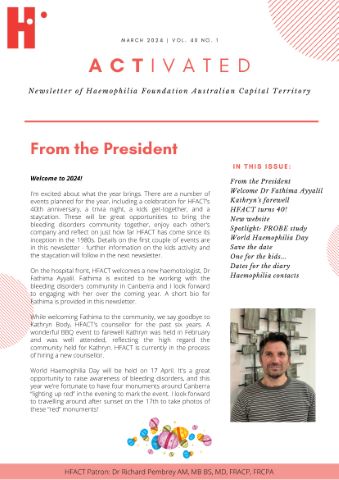
Fiona is in her early 50s and found out she had von Willebrand disease (VWD) when she was 6 years old. She comes from a family with a long history of VWD.
My dad’s mother had 9 children, 8 of whom had VWD, including my dad, so it was talked about quite regularly in our household.
I grew up living normally. I played sport and my friends didn’t know – and to think of it, I don’t think the school ever knew. It was normal in our household to have nosebleeds, bruises, cuts, grazes. The only thing different was we had bandages on our bodies not Band-Aids®, we had ice packs on our joints or bruises and nosebleeds that bled for hours not minutes.
If you asked the question, what was it like as a teenager as a girl with VWD in those days, I would’ve said it was a nightmare. No information, periods were a nightmare, but you thought they were normal, heavy bleeding with large clots and no one to ask. My mother didn’t understand as she didn’t have VWD and my sister was older than me and had moved out by the time I started my periods. It was a learn to cope type of thing. It is totally different now and so much information is available.
I don’t have regular treatment, only on demand when I have a bleed. Being from a regional area, it took me two years to organise factor storage at the local hospital so that it is available when I need it. Living with VWD can be a tiresome and arduous affair, especially when you see new doctors, dentists or any other medical professionals. You have to make sure you explain that you have VWD and make sure the medication they are giving you won’t cause a bleed or extensive bruising. My Haemophilia Treatment Centre has helped me with this. For example, recently with one phone call from me about an upcoming dental procedure, they contacted my dentist and gave them the information required. I am so grateful to my HTC team for making it so easy to deal with.
My one bit of advice is to speak up: advocate for yourself and your children. Heavy periods are not normal, find out why. A lot has changed in the last 50 years. There is so much information around, you just need to ask.
What is VWD?
VWD is the most common type of bleeding disorder worldwide. It affects both males and females. Most people with VWD have the mild form. They may not be diagnosed until they have surgery, experience a major accident, or have serious bleeding after childbirth.
VWD can be difficult to diagnose and needs to be done by specialists with experience in VWD.
With all forms of VWD there can be bleeding problems. Some people with VWD bleed quite often, eg with nosebleeds, bruising and heavy periods. A smaller number of people have the severe form of VWD and may also experience joint and muscle bleeds, similar to haemophilia.
Any bleeding that occurs with VWD needs to be assessed and treated.
For more information visit www.haemophilia.org.au/VWD
VWD in females – https://www.haemophilia.org.au/about-bleeding-disorders/women-with-bleeding-disorders/vwd-in-females
Female Factors https://www.haemophilia.org.au/publications/information-resources/women-with-bleeding-disorders/young-women


